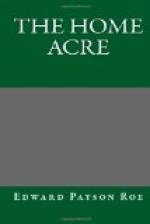If, just before the fruit begins to ripen, a mulch of leaves, cut grass, or any litter that will cover the ground slightly, is placed under and around the bushes, it may save a great deal of fruit from being spoiled. The raspberry season is also the hour and opportunity for thunder-showers, whose great slanting drops often splash the soil to surprising distances. Sugar-and-cream-coated, not mud-coated, berries, if you please.
In my remarks on raspberries I have not named many varieties, and have rather laid stress on the principles which may guide the reader in his present and future selections of kinds. Sufficient in number and variety to meet the needs of every family have been mentioned. The amateur may gratify his taste by testing other sorts described in nurserymen’s catalogues. Moreover, every year or two some new variety will be heralded throughout the land. The reader has merely to keep in mind the three classes of raspberries described and their characteristics, in order to make an intelligent choice from old and new candidates for favor.
It should also be remembered that the raspberry is a Northern fruit. I am often asked in effect, What raspberries do you recommend for the Gulf States? I suppose my best reply would be, What oranges do you think best adapted to New York? Most of the foreign kinds falter and fail in New Jersey and Southern Pennsylvania; the Cuthbert and its class can be grown much further south, while the Turner and the black-caps thrive almost to Florida.
Raspberries, especially those of our native species, are comparatively free from disease. Foreign varieties and their hybrids are sometimes afflicted with the curl-leaf. The foliage crimps up, the canes are dwarfed, and the whole plant has a sickly and often yellow appearance. The only remedy is to dig up the plant, root and branch, and burn it.
A disease termed the “rust” not infrequently attacks old and poorly nourished black-cap bushes. The leaves take on an ochreous color, and the plant is seen to be failing. Extirpate it as directed above. If many bushes are affected, I advise that the whole patch be rooted up, and healthy plants set out elsewhere.
It is a well-known law of Nature that plants of nearly all kinds appear to exhaust from the soil in time the ingredients peculiarly acceptable to them. Skill can do much toward maintaining the needful supply; but the best and easiest plan is not to grow any of the small fruits too long in any one locality. By setting out new plants on different ground, far better results are attained with much less trouble.
CHAPTER VI
THE CURRANT




